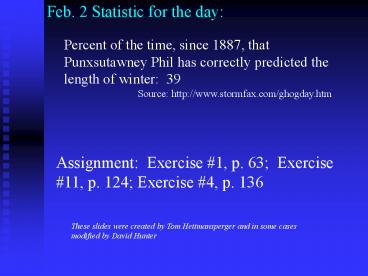Feb. 2 Statistic for the day: - PowerPoint PPT Presentation
1 / 19
Title:
Feb. 2 Statistic for the day:
Description:
Female waitress: Drawing a smiley face increased tip significantly. Male waiter: Drawing a smiley face decreased tip, though not significantly. Source: Journ. ... – PowerPoint PPT presentation
Number of Views:59
Avg rating:3.0/5.0
Title: Feb. 2 Statistic for the day:
1
Feb. 2 Statistic for the day
Percent of the time, since 1887, that
Punxsutawney Phil has correctly predicted the
length of winter 39 Source
http//www.stormfax.com/ghogday.htm
Assignment Exercise 1, p. 63 Exercise 11,
p. 124 Exercise 4, p. 136
These slides were created by Tom Hettmansperger
and in some cases modified by David Hunter
2
- Research question Does a chemical QS when added
- to sun tan lotion enhance tanning when mixed with
Coppertone? - Response Tanning index
- Explanatory Variable QS or not.
- What sort of study?
- Randomized Experiment?
- Observational Study?
Randomized Experiment.
3
(No Transcript)
4
There is a lot of overlap between the
boxplots. This suggests that there is NOT a
significant difference between QS and W/O QS.
5
The problem Too much variability within the
two groups due to variation in tanning ability.
We need to eliminate some of the
within variability. Then we may be able to
detect the difference across the two groups.
6
The answer is to let each subject be his/her own
control. RANDOMLY assign QS or not to left or
right side of the body. The experimental design
is called PAIRED DATA DESIGN. Tan for 3
hours. Measure the tanning index. Record the
difference between QS and W/O QS
7
Notice that the treatments are only compared
within a subject.
8
Boxplot of 10 differences within subjects. Note
that the entire data set is above 0. This
means QS had higher index than W/O QS for all
subjects.
9
(No Transcript)
10
Unpaired
Paired
11
Research question How prevalent is cheating at
PSU?
Imagine the following study
Individual students taking an exam in a
particular course are filmed and observed closely
by a team of extra observers, who then record the
number of instances of cheating they observe.
Any problems with this?
Hawthorne Effect!
12
Research question Do cell phones cause cancer?
- What sort of a study could be used to answer
this? - Observational Study?
- Randomized Experiment?
Observational Study If we cannot establish cause
and effect, can we establish an association
between cell phones and cancer?
13
Observational Study Response Variable whether
or not a subject gets cancer. Explanatory
Variable whether or not the subject uses a
cell phone. Randomly select people who use cell
phones and record the who get
cancer. Randomly select people who never use
cell phones and record the who get
cancer. This may require a very long time.
14
- A special kind of observational study
- SWITCH RESPONSE AND EXPLANATORY VARIABLES
- Response Variable whether a subject uses a cell
phone or not - Explanatory Variable whether a subject has
cancer or not. - Select a sample of cancer patients (Cancer Case)
- Develop a group of people who match the
- cancer patients but do not have cancer.
(Control) - Compute the who use cell phones in each group.
- Called a Case-Control Study
15
Also Called Retrospective Case-Control
Study Retrospective because we asked subjects if
they have been using cell phones in the
past. Note that since we only look for an
association it does not matter which variable is
the response and which is the explanatory.
Suppose we take 100 cancer patients and then
take 200 non-cancer patients in the same hospital
as controls.
16
Data
17
Plot with Margins of Error
We would probably conclude that there is little
or no association between using cell phones and
cancer.
18
Research question How does putting a smiley
face on the bill influence a waitpersons tip?
- Interacting variable Sex of waitperson
- Female waitress Drawing a smiley face increased
tip significantly - Male waiter Drawing a smiley face decreased
tip, though not significantly
Source Journ. Appl. Soc. Psych, 1996
19
Interaction plot Smiley-face experiment































